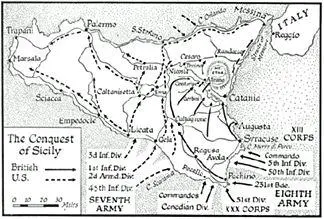The last Japanese thrusts had been hurled back and the enemy was now everywhere on the defensive. The Japanese were compelled to reinforce by costly processes the positions they still held in New Guinea, especially the garrisons of Salamaua and Lae, and to build a series of supporting airfields along the coast. The American movement towards the Philippines began to be defined. General MacArthur was working westward along the north coast of New Guinea, and Admiral Halsey was slowly advancing along the island chain of the Solomons towards Rabaul. Behind all towered up the now rapidly rising strength of the United States. The eighteen months which had passed since Pearl Harbour had revealed to the Closing the Ring
41
rulers of Japan some of the facts and proportions they had ignored.

Closing the Ring
42
2
The Conquest of Sicily July and August 1943
Preparations for Invading Sicily — General Alexander’s Final Plan — Order of Battle —
Concentration of Widespread Forces — Hitler’s Conference of May 20 — Our Seizure of Pantelleria Island — Successful Cover Plans — The Appointed Day, July 10 — An Ugly Turn of the Weather — Serious Air Losses — Successful Seaborne Landings — Advance of the British and American Armies — Our Next Strategic Move —
My Telegram to Smuts of July 16 — Progress of the Campaign — Eisenhower Declares for the Invasion of Italy — Discussions Between the British and American Chiefs of Staff — General Patton’s Fine Advance — Centuripe, Catania, and Messina — Alexander’s Report — Sicily Liberated in Thirty-Eight Days.
THE CASABLANCA CONFERENCE In January decided to invade Sicily after the capture of Tunis. This great enterprise, known by the code-name “Husky,” presented new and formidable problems. Severe resistance had not been expected in the “Torch” landing, but now the still numerous Italian Army might fight desperately in defence of its homeland. In any event it would be stiffened by strong German ground and air forces. The Italian Fleet still possessed six effective modern battleships and might join in the battle.
Closing the Ring
43
General Eisenhower considered that Sicily should be attacked only if our purpose was to clear the Mediterranean sea-route. If our real purpose was to invade and defeat Italy, he thought that our proper initial objectives were Sardinia and Corsica, “since these islands lie on the flank of the long Italian boot and would force a very much greater dispersion of enemy strength in Italy than the mere occupation of Sicily, which lies off the mountainous toe of the peninsula.” 1 This was no doubt a military opinion of high authority, though one I could not share. But political forces play their part, and the capture of Sicily and the direct invasion of Italy were to bring about results of a far more swift and far-reaching character.
The capture of Sicily was an undertaking of the first magnitude. Although eclipsed by events in Normandy, its importance and its difficulties should not be underrated.
The landing was based on the experience gained in
“Torch,” and those who planned “Overlord” learned much from “Husky.” In the initial assault nearly 3000 ships and landing-craft took part, carrying between them 160,000
men, 14,000 vehicles, 600 tanks, and 1800 guns. These forces had to be collected, trained, equipped, and eventually embarked, with all the vast impedimenta of amphibious warfare, at widely dispersed bases in the Mediterranean, in Great Britain, and in the United States.
Detailed planning was required from subordinate commanders whose headquarters were separated by thousands of miles. All these plans had to be welded together by the Supreme Commander at Algiers. Here a special Allied Staff controlled and co-ordinated all preparations. As the plan developed, many problems arose which could only be solved by the Combined Chiefs of Staff. Finally, the convoys had to be assembled, escorted


Closing the Ring
44
across the oceans and through the narrow seas, and concentrated in the battle area at the right time.
Planning at General Eisenhower’s Headquarters had begun in February. It now became necessary to appoint his principal subordinates.
In all wars where allies are fighting together the control of strategy usually rests in the main with whoever holds the larger forces. This may be modified by political considerations or the relative war effort in other theatres, but the principle that the more powerful army must rule is sound. For reasons of policy we had hitherto yielded the command and direction of the campaign in Northwest Africa to the United States. At the beginning they were preponderant in numbers and influence.
1 comment